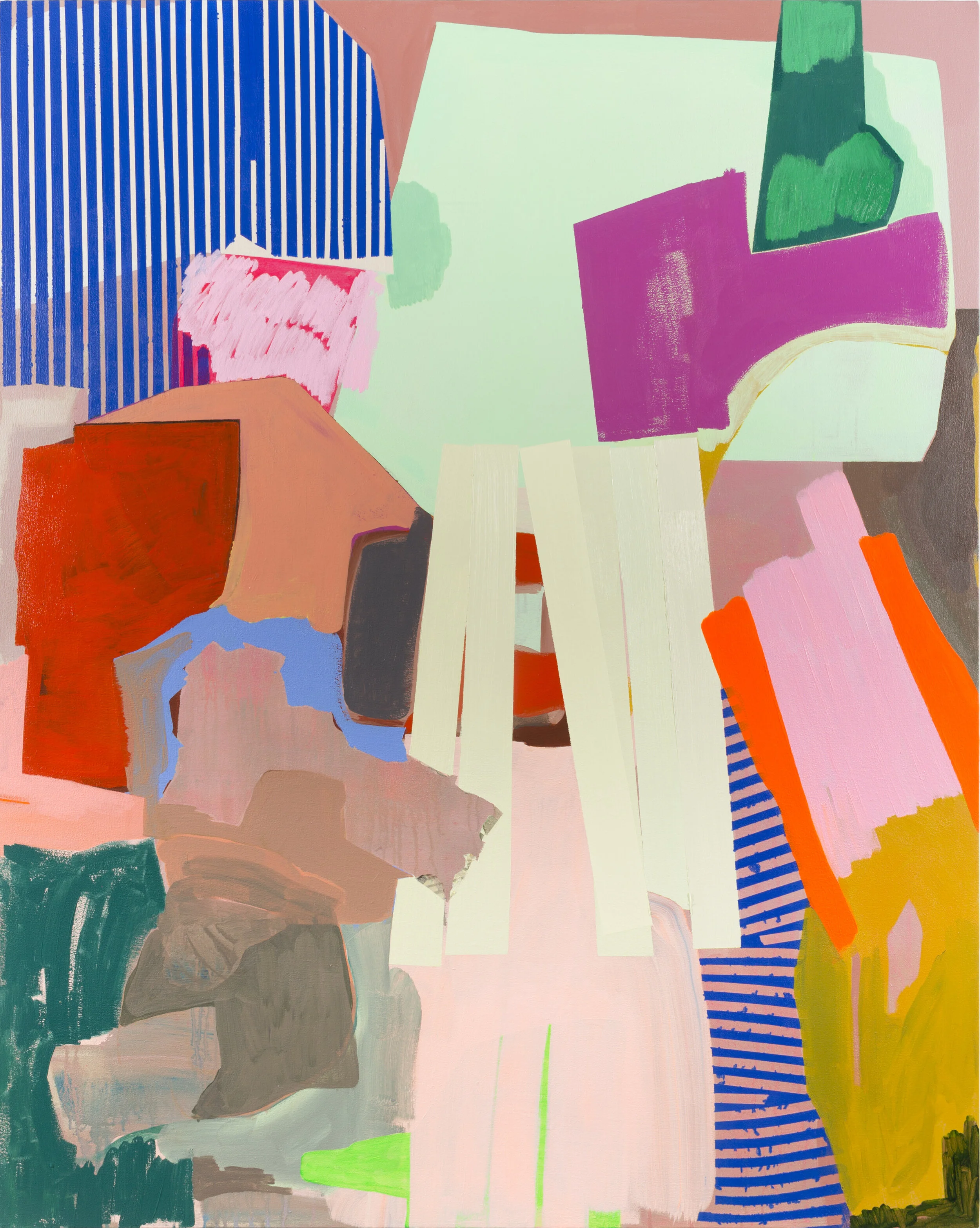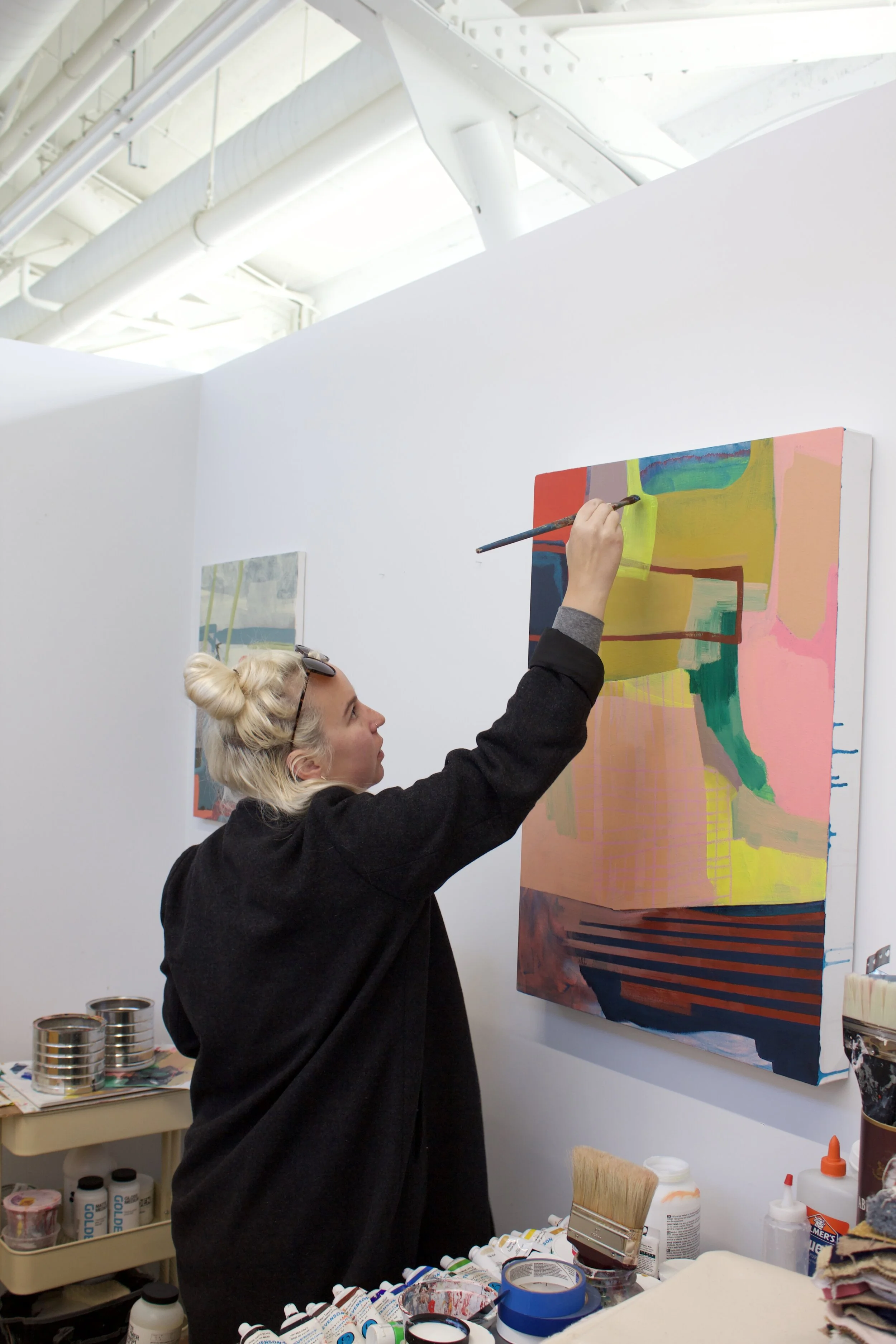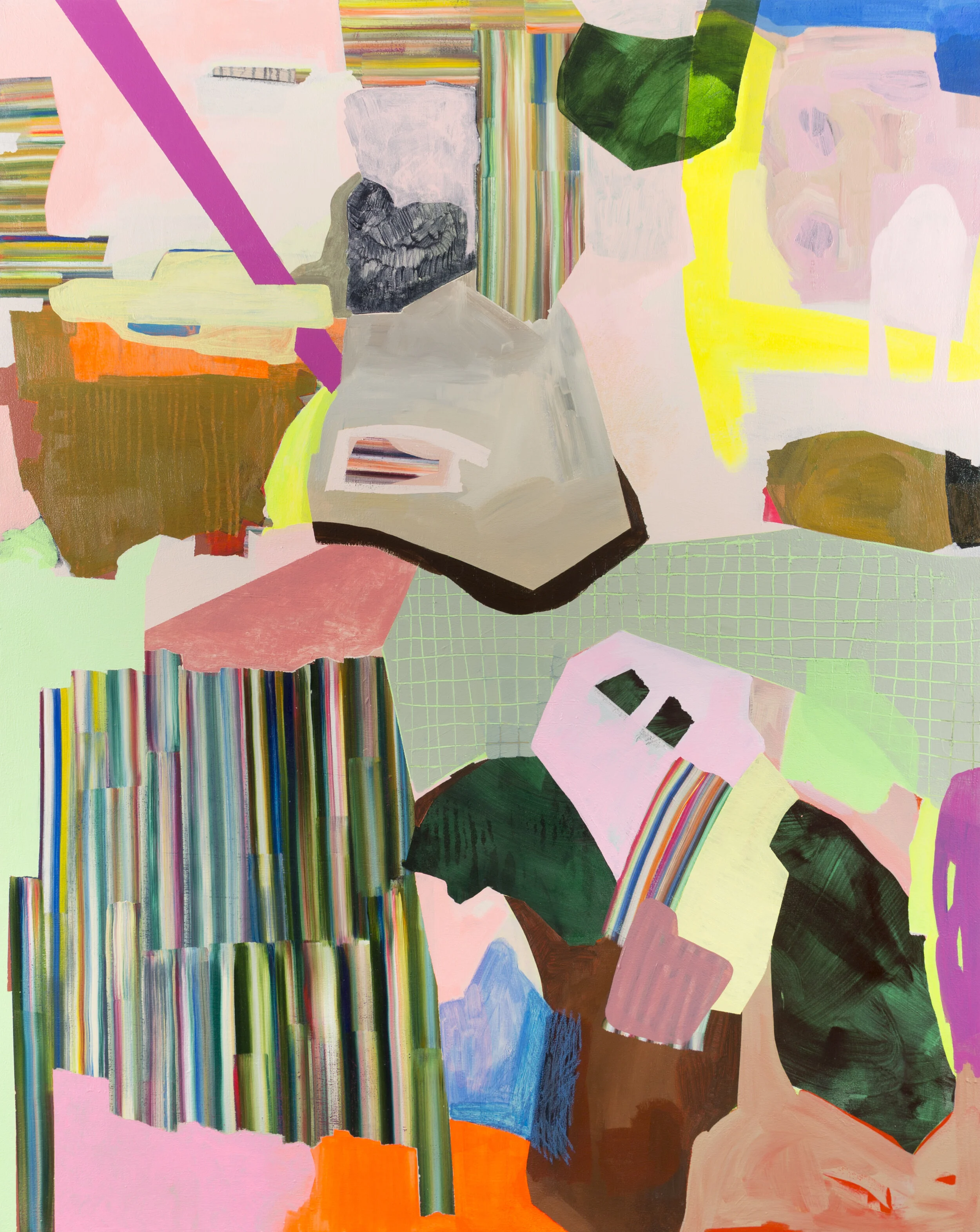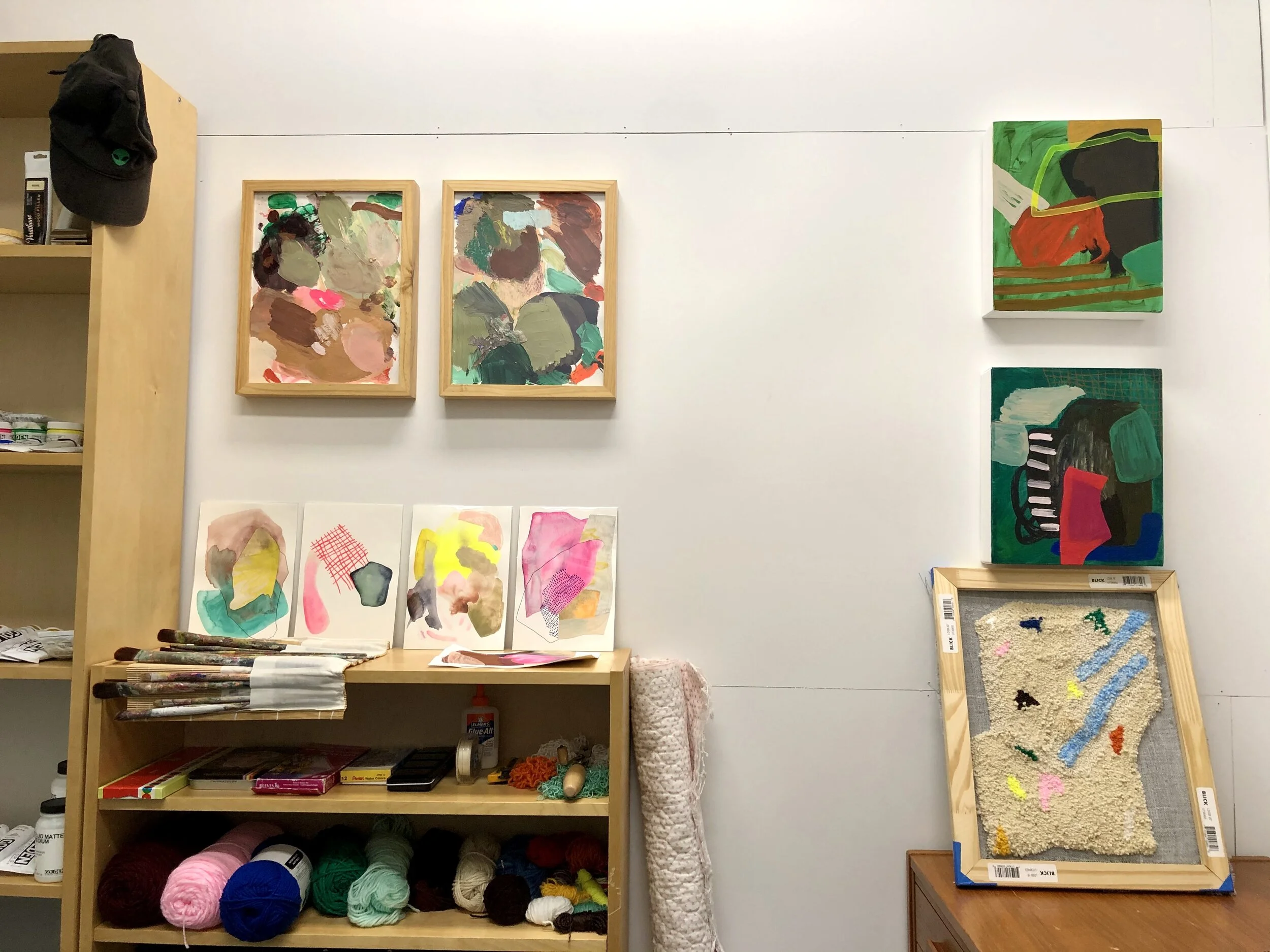In the Studio with Jordan Holms
Jordan Holms
is an interdisciplinary artist from Vancouver, Canada. Holms completed her MFA and MA simultaneously at the San Francisco Art Institute and has gone on to produce work that is informed by the spaces in which we inhabit and navigate, abstracting her experiences into bold and colorful compositions. Holms spoke with Alison Poon about urban and domestic spaces, color as a political statement and changes to the way the art world operates.
INTERVIEW WITH JORDAN HOLMS
Alison: What are your main sources of inspiration as an artist?
Jordan: I try to consider everything bound up in what we define as inhabited space, and objects that produce space - furniture, decorative molding on houses, cement barricades, wire fences, wallpaper, traffic signs, upholstery, pylons, venetian blinds. I look to things we find in our homes and in the built environment that signal how that space is organized and materialized, translating their colors, forms, and textures into abstract compositions. I incorporate references to craft and textiles into my paintings as well. Some feature textile-inspired patterns as signifiers of domestic space, while still using abstraction to fold the home and the city - seemingly discrete private and public economies of space – in on one another. I take note of the ways in which a space reveals its history. For instance, walls that have clearly been graffitied on and then someone has come along and tried to cover it up with a shade of paint that is almost, but not exactly, the same as the original. I spend time walking around the city taking pictures of the bizarre color combinations of the row houses, or the fluorescent spray-painted marks on sidewalks where the concrete has been compromised. I used to make collages from the images and then paint based on those collages, but after a while I have built up such a large lexicon of imagery that now I often draw on my memory bank and compose paintings that way.
Alison: What does your work aim to do?
Jordan: My work grapples with our fraught relationship to the built environment. I’m interested in how space is materialized, organized, and how spaces produce meaning. I think a lot about how to unsettle the presumed divisions between public and private space. I consider my work to arrive at more nuanced definitions of “space.” My intention is to emphasize the formal properties of a given space or amalgamated spaces and then translate those compositional elements into paintings or works in other mediums. Overall, I’m more concerned with the intimation or suggestion of space, rather than direct quotation. So, my work really hinges on translation as a formal strategy.
Alison: While your work looks at different environments, it also is concerned with people/ bodies. Could you explain the role of people in your artworks?
Jordan Holms studio shot, 2020
Jordan: I think that a useful way to talk about my interest in people and bodies is by navigation, transition, and relocation. These are re-occurring themes, and early on I engaged with how spaces become occupied and vacated and then I started to crystallize ideas about how the intersection between objects and people produce spatial relations. Another useful way would be to consider the formal properties of my work, such as the prominence of fluorescent colors. I’m interested in them because they are highly instructional colors. When we encounter neons or fluorescents in the built environment they are typically dictating how bodies have to navigate through a space. They are incredibly authoritative colors, formally and politically, so I think there’s a lot of aesthetic and political richness there. Stripes and grids are important too, for their duality, as historically, they have operated as signifiers of both power and oppression – for example, the American flag or 19th century prison uniforms. Architecturally fences and window blinds both act as delineations of space that we can’t physically pass through, but we can gaze through them and visually penetrate a space that we aren’t meant to enter. So, they designate space – they create a here and a there, an inside and an outside. And it is that “here and there” that I’m trying to collapse in on one another.
Alison: Your works are very colorful and bold. How do you select the colors you use?
Jordan: I have long collected imagery relating to domestic spaces and urban architecture. Relocating to San Francisco concretized my image collection and legitimized a lot of my formal interests in color. The Bay Area is one of the few regions in the United States where you can un-ironically paint your house eggplant purple with canary yellow trim, or mint green with Pepto-Bismol pink and not have the rest of the neighborhood melt down about it. Where I grew up, those kinds of palettes were very rare, but in San Francisco I have endless source material. In that sense, the color choices become a way to undermine the civic or social authorities that dictate how a neighborhood, or an entire city “should look.” In recent years, San Francisco homes are being painted gray - I suppose for a housing developer, gray is a neutral, palatable color for potential buyers. However, it is also a surrender to aesthetic homogeneity that codes the gray as more “tasteful” than the unconventional and eccentric color schemes of the surrounding houses. I consider all of the ostentatiously painted houses still standing as forms of spatialized resistance, and I try to emulate and preserve those convictions in my paintings.
Alison: Recently you introduced textile mediums into your work. Could you explain why you chose to try this new medium and its conceptual importance?
Jordan: I have been experimenting with incorporating textiles and other fiber-based practices into my work for many years. My mother and both of my grandmothers did a lot of quilting, knitting, embroidery and other textile work while I was growing up, and my sister works in fashion; so, I have always been saturated in fiber practices. I recently taught myself how to do carpet tufting. This feels like a natural progression for my work because rugs and carpets have a very significant material relationship to domestic space. I am also interested in material accretion; this is evident in some earlier fiber sculptures I produced. I do a lot of layering in my paintings and the carpet tufts have become a more direct way to communicate texture, as well as the aggregation of materials. The idea with the tufts is to emphasize the labor, ritual, and repetition bound up textile work and its association to the domestic, while also foregrounding how domestic work is devalued precisely because it is often repetitive and ubiquitous. I also enjoy the reciprocity between the tufts and the paintings. I often borrow compositional elements from one medium to translate to the other, which has proven to be very generative for the development of my work in both mediums.
Alison: Domestic and civic spaces are often the areas we are the most familiar with. How do you compare these?
Odd Oblongs, 2018
Acrylic on canvas
60 x 48 in.
Jordan: While the domestic and civic have long been characterized as oppositional spaces, the idea of the pure separation between the private and public realms is an incredibly a-historical narrative. In order for a capitalist society to function, we are required to operate socially and politically under the assumption that the public realm is this self-sustaining structure. In reality, much of the work done in the domestic realm functions primarily to support and maintain the activities executed in the public sphere. The conceptual-performance artist Mierle Laderman Ukeles explains the ways in which private and public spaces are differently coded in her Manifesto and Maintenance Art. For Ukeles, Maintenance Art encompasses labor that patriarchal capitalists deem non-formal work such as childbirth, caregiving and domestic household upkeep, as well as many forms of public sanitation, custodial, and preservational work. Through reframing, she demonstrates that the labors that takes place in the domestic sphere are not only erased and stigmatized in the public sphere, but are also essential to sustaining the hegemonic systems that compose the civic realm. Through this work, Ukeles refutes the prevailing fallacy that the public sphere functions autonomously and separate from the invisible forms of labor that take place in the domestic sphere.
Alison: Coronavirus has made us think very differently about the spaces we inhabit and has placed great restrictions on movement. How has this affected you and your practice both practically and conceptually?
Jordan: Practically speaking, the effects on my studio practice were immediate. When the Bay Area went into shelter-in-place in mid-March, I moved my studio into my apartment, and suddenly, I was no longer in charge of deciding the scale of my work. Rather, scale and materials were predetermined by my own home. I also travel quite frequently, incorporating a lot of those experiences as source material for my work. Due to the restrictions on movement, I have already been spending much more time paying attention to the spaces that I frequent on a daily basis. Although the domestic has always been an interest, spending so much more time at home, I have begun thinking about how my work might signal something about the domestic in less anachronistic ways than traditional narratives - how I can be more nuanced about the ways in which I articulate signifiers of the domestic in my work. I have also been spending a lot of time not making art during the pandemic. It has taken me a long time to learn that it is important to consider things outside of production as part of my process. In the past, I’ve been quite tough on myself for not working longer hours in the studio, but I’ve come to realize that a large part of what I do requires me to just let images, forms, textures, and colors percolate in the back of my head until I can compose them into something I want to make. I have come to value this kind of non-traditional research as equally productive and crucial to my practice as time spent producing work in the studio.
Alison: How do you see your practice developing in the future?
Jordan: I am excited about the shifts in scale and materials that are occurring due to the pandemic. Recently, I have moved to a full-time studio practice, which gives me more time for experimentation. I have been getting back into watercolors, as well as teaching myself how to do carpet tufting, which are both more amenable to working exclusively from home. I think that as time goes on, my practice will also shift conceptually to focus much more explicitly on the local. Spending so much more time at home, especially in the first few months of the pandemic, I spent at a lot of time thinking about confinement, transition, spatial restriction, ideas that lend themselves easily enough to the subject matter already present in my work. I think we will see a lot of “quarantine” art related to these concepts. I am also beginning to work on a new body of paintings that examine the grid in relation to its formal and political connotations. All that said, it has also been increasingly difficult to make future plans for the development of my art practice when the global situation is so unstable, so I suppose I’m just trying to remain in the here and now as much as I can.
I’m also a person who has always been interested in processes that require highly specific skill sets. For example, my earliest interest in art was a very detailed portrait painting. I’m also a formerly sporty person who could happily juggle a soccer ball for hours. Technical stuff draws me to it, and once I get a problem in my head, I won’t stop until I figure it out. I have found that this mentality is probably the best asset I have as a new media type person.




